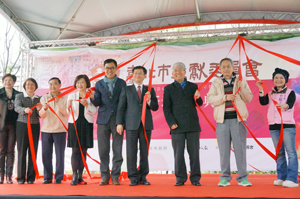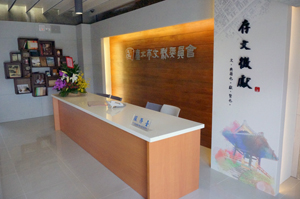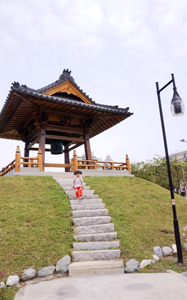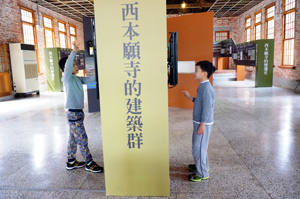Taipei City Archives celebrates its new historical home
By Hermia Lin The organization, supervised by the Department of Cultural Affairs of Taipei City, has been dedicated to preserving and promoting the history of Taipei since its establishment in June 1952. It moved 7 times before settling at the former Buddhist compound, which has the potential to become the next big tourist attraction in Taipei. At a launch ceremony held at the site on March 15, Liu Wei-gong, who doubles as the commissioner of the Department of Cultural Affairs and the chairman of Taipei City Archives, said he is pleased to see the archives find a new home, adding that it symbolizes a brand new beginning for both the archives and the former temple alike. The organization's tasks will start afresh as well, changing from a focus on research and publications on the history of Taipei to managing exhibitions and engaging with local residents. "Taipei City Archives will make the area (Wanhua) prosper and we will make the residents proud," Liu assured. Taipei deputy mayor Chang Chin-oh, who also attended the ceremony, talked about the importance of shaping history with modern approaches. "The present is also a part of history. By combining the present with the past, history will have a fresh outlook. Taipei City will celebrate the 130th anniversary of its establishment this year, and we'd like to let more people know about the glory of Wanhua," he said. A taste of former glory Nishi Honganji Temple (the Western Temple of the Original Vow) and Higashi Honganji (the Eastern Temple of the Original Vow) are the headquarters of two branches within the Jodo Shinshu (True Pure Land Buddhism) school, one of Japan's biggest Buddhist denominations. The two temples are situated in the center of Kyoto in west Japan. Nishi Honganji Temple was designated as an UNESCO World Heritage Site in 1994. Jodo Shinshu came to Taiwan during the Japanese colonial period (1895-1945) and the Taiwanese branch of the base temple started construction in 1901, followed by 30 years of tedious work. The Taipei temple became the largest Buddhist temple, in terms of scale and size, in the country during the colonial period. The designers spared no expense, furnishing the grounds with splendid wood carvings, especially in the main shrine hall. The artwork is enthralling to anyone regardless of their religious background. According to Lin Cheng-wei, assistant professor at Taipei National University of the Arts, the temple's Taipei installment, in addition to being perhaps the most spectacular Buddhist complex at the time, was also an important social and educational venue for Taiwanese people. Women would come to learn knitting and flower arrangement. Speeches, exhibitions, and the occasional memorial service were also held here, Lin said. Then a fire broke out on the grounds in 1975, destroying almost everything. The once lively temple became a dwelling place for people seeking temporary shelter. Dozens of immigrants and laborers from Japan, China, and local Taiwanese made use of the remaining structure and lived there for quite some time. Their life was a miniature portrait of Taiwan's patchwork immigrant society at the time. The temple's Tree Heart Hall is a unique glimpse into an architectural style which draws upon Japanese and Western influences. In contrast with the main structure, built from red brick, the entrance is a remarkable Japanese gate, or karamon, a type of gate often seen in Japanese architecture. The Bell Tower, sitting on a small hill towards the site's central entrance, affords passersby a view of the beautiful wooden frames used in Japanese roofs and pillars. The Tree Heart Hall and the Bell Tower have been mostly restored to their original look. The main shrine, which was mostly lost in the 1975 fire, was restored only at its base. The base now serves as the office for Taipei City Archives. The evolution and transformation of the former Japanese temple is now featured in an ongoing exhibition at the Tree Heart Hall, which runs until May 4. The exhibition is open from 10 am to 5 pm from Tuesdays to Sundays. Exhibition: the Taipei of old If you are looking to take a step into the tumultuous and colorful past of the capital city, the permanent exhibition that runs in the corridor of the Taipei City Archives is the place to visit. Divided into three sections, the exhibition takes viewers back to the period between the 1920s and 1940s through archive photographs and images. The first section, featuring a 3m-long map of Taipei drawn in 1935, marks some of the most important landscapes and buildings of Taipei. Coupled with archive photographs and postcards, the images leave a strong impression of the forces that rapidly shaped the city landscape. The second part showcases works by Taiwanese photographers Deng Nan-guang, Chang Tsai, Lee Chun-lun and Lee Ho-tseng, who captured Taiwanese people from all walks of life in the 1930s to the 1950s with their candid pictures. The photographs are part of the archive collection. The third section portrays city life from the 1920s to the 1940s through items and documents. A phonograph and several vinyl records are hints of the drastic changes that occurred during this period. In July 1911, the first cinema house opened in Ximenting, the first of its kind in Taiwan. The movie theatre was later modified into the Ambassador Theatres. Fashion changed quickly with the passing decades. In the early 1910s, Japanese attire was in vogue with Taiwan's residents. In less than 30 years, Western attire swept over almost the entire island, effectively nudging out Japanese wear. The first department store of Taiwan was set up in the Ximenting area in 1932. For consumers in Taipei, shopping was previously an unpleasant experience, for vendors would make a grand show of displeasure in the battle for a bargain. The establishment of the first department store allowed both Japanese and Taiwanese locals to shop in a casual and stress-free atmosphere. Plan a visit to the new home of Taipei City Archives! The two exhibitions will surely transport you to an era of elegant prosperity.
Staff Writer Nishi Honganji Temple , the lesser-known historical site on Zhonghua Rd. in Ximenting, Taipei, has opened a new chapter in its decades-long history after Taipei City Archives celebrated moving into the complex earlier this month.
Nishi Honganji Temple , the lesser-known historical site on Zhonghua Rd. in Ximenting, Taipei, has opened a new chapter in its decades-long history after Taipei City Archives celebrated moving into the complex earlier this month. The former Nishi Honganji Temple of Taipei has more than one reason to shine amongst the many landmarks in the city's landscape. If you take a stroll along Zhonghua Rd. in Ximenting, an area more popularly known as "Taipei's Times Square," it is hard not to be struck by the tranquil atmosphere the Japanese-style architecture from the former temple brings to the other bustling area.
The former Nishi Honganji Temple of Taipei has more than one reason to shine amongst the many landmarks in the city's landscape. If you take a stroll along Zhonghua Rd. in Ximenting, an area more popularly known as "Taipei's Times Square," it is hard not to be struck by the tranquil atmosphere the Japanese-style architecture from the former temple brings to the other bustling area. In 2005, the city government began renovating the area, designating the compound as a historical site in 2006. Intensive restoration efforts commenced right after the city government took over the grounds. The careful restoration, which lasted seven years, helped breath life into some of the temple's former magnificence.
In 2005, the city government began renovating the area, designating the compound as a historical site in 2006. Intensive restoration efforts commenced right after the city government took over the grounds. The careful restoration, which lasted seven years, helped breath life into some of the temple's former magnificence. Besides Japanese and Chinese films, art house films from Russia, Germany, France and Italy were also released in Taiwan at the time. In 1922, the first feature film produced by a Japanese studio was released in theatres. The first film magazines were published in the 1930s. By the end of the Japanese colonial period, there were 48 movie theatres across Taiwan, with 16 in the capital city alone. Ximenting became the center of entertainment in Taipei.
Besides Japanese and Chinese films, art house films from Russia, Germany, France and Italy were also released in Taiwan at the time. In 1922, the first feature film produced by a Japanese studio was released in theatres. The first film magazines were published in the 1930s. By the end of the Japanese colonial period, there were 48 movie theatres across Taiwan, with 16 in the capital city alone. Ximenting became the center of entertainment in Taipei.

![Taiwan.gov.tw [ open a new window]](/images/egov.png)
